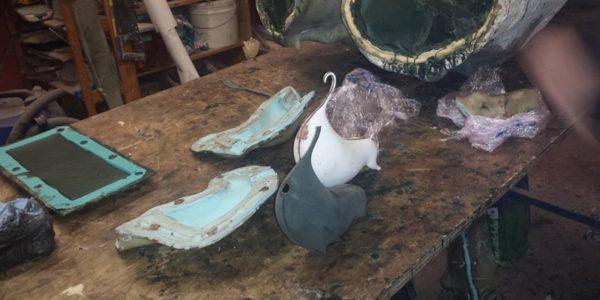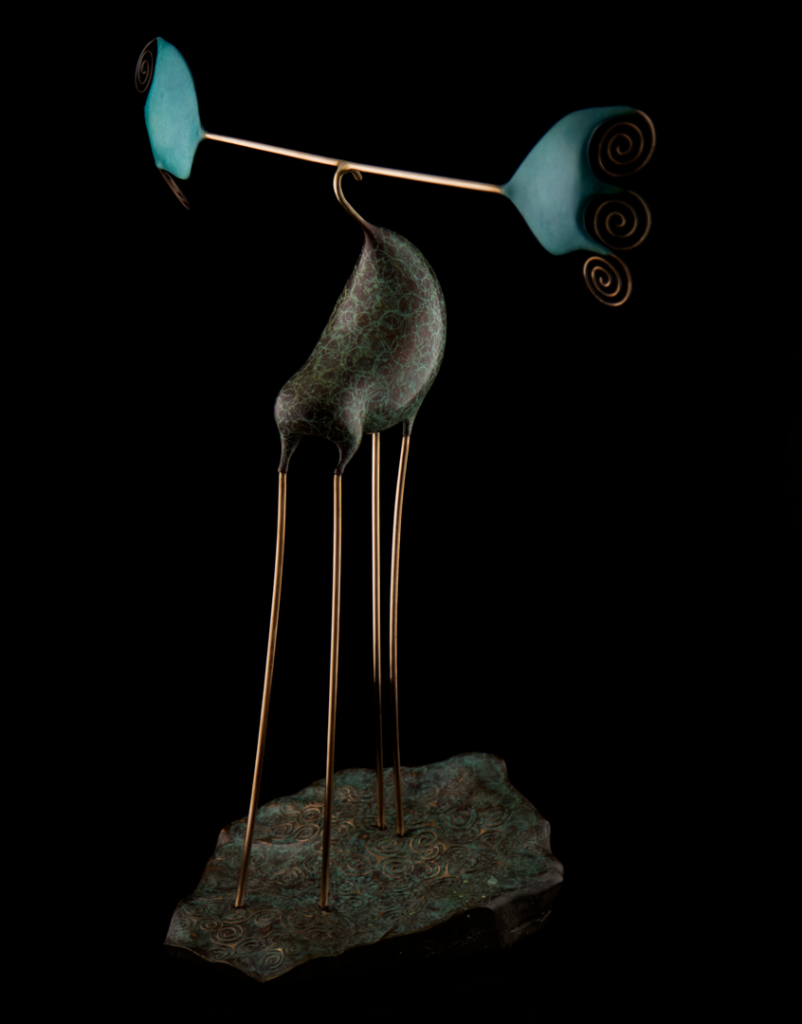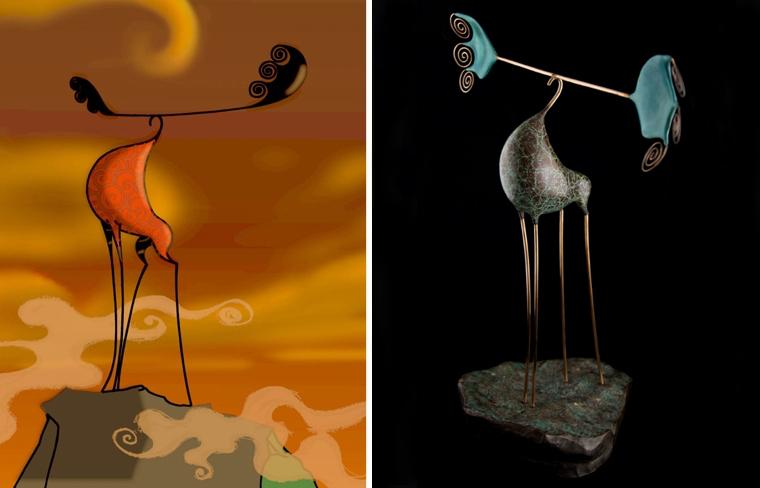The Great Irish Elk was a majestic creature of heroic proportions that became extinct some 11,000 years ago. In a short movie by Brown Bag Films, created in 1998 and set in 9000 BCE, the last of the beasts’ days were imagined in all of their tragic beauty. The film follows the final interactions of a surviving male elk with the last of his kind, and then finally meeting his end at the hands of a tribe of hungry humans. The filmmakers chose to depict the elk as symbols of themselves, near tear-shaped bodies atop spidery legs, their heads supplanted by a pair of elaborate and impressive antlers, reminiscent of the ancient cave paintings created by those who were impressed by their beauty and stature when they still roamed the Earth.
In conjunction with Cathal Gaffney, the co-founder of Brown Bag Films, digital sculptor and model maker Seán Forsyth worked to bring the beautiful the animation into 3D space. To do this, he used a combination of old world technique and new world technology.
 The first step in their realization was to move the character from the flat screen to the maker’s hands. This was done by 3D printing a digital model created of the elk’s various components. That 3D piece was used to press into the wax as the first step in making the molds necessary for casting in bronze. After the wax pieces were perfectly shaped, each one was dipped nine times in a ceramic coating in order to create a mold that would be strong enough to handle the molten bronze that was to fill them.
The first step in their realization was to move the character from the flat screen to the maker’s hands. This was done by 3D printing a digital model created of the elk’s various components. That 3D piece was used to press into the wax as the first step in making the molds necessary for casting in bronze. After the wax pieces were perfectly shaped, each one was dipped nine times in a ceramic coating in order to create a mold that would be strong enough to handle the molten bronze that was to fill them.
 This technique is called ‘lost wax’ or cire perdue, because after the wax has been coated with a ceramic shell, the entire wax/ceramic mass is placed in an oven until all of the wax melts and runs out. This leaves the hard ceramic shell with a hollow center in the desired form. It is into that shell that the molten bronze, heated to 1,200 degrees Celsius, is poured. Once it has cooled sufficiently, the pieces are removed from the molds and welded together to create the complete creature.
This technique is called ‘lost wax’ or cire perdue, because after the wax has been coated with a ceramic shell, the entire wax/ceramic mass is placed in an oven until all of the wax melts and runs out. This leaves the hard ceramic shell with a hollow center in the desired form. It is into that shell that the molten bronze, heated to 1,200 degrees Celsius, is poured. Once it has cooled sufficiently, the pieces are removed from the molds and welded together to create the complete creature.
Only nine of these sculptures were produced, each individually colored using a process called applied patination which distresses the bronze and creates a palette of hues from white to brown to green. The elk were placed on a bronze precipice in keeping with one of the most striking and iconic moments in the film.
The film is beautifully touching, although at first, I thought it possibly a bit heavy handed in its portrayal of the humans who bring the elk to their end, shown with glowing green eyes and terrifying ragged visage. The sculptures are no less moving, their stylization removing what could possibly have been a melodramatic and overly sentimental tone. The simplicity of the form makes them quite accessible and the authenticity of the materials and processes for their creation in 3D elevates them above mere models of the cartoon.
 I watched the film with my 9-year-old daughter who was captivated by its artistry. The day before yesterday, a driver hit a deer with his car, right in front of our house. As we went out to help, the deer tried to struggle to its feet, panting heavily and with fear writ large through its body. It was unable to rise and after a series of attempts, lay down its head in the thick leaves at the base of the forest that surrounds our house and died. My family stood in silence, my daughter, with tears running down her face and her eyes fixed on the extinguished creature before her, whispered, “This is what we were to the last elk.”
I watched the film with my 9-year-old daughter who was captivated by its artistry. The day before yesterday, a driver hit a deer with his car, right in front of our house. As we went out to help, the deer tried to struggle to its feet, panting heavily and with fear writ large through its body. It was unable to rise and after a series of attempts, lay down its head in the thick leaves at the base of the forest that surrounds our house and died. My family stood in silence, my daughter, with tears running down her face and her eyes fixed on the extinguished creature before her, whispered, “This is what we were to the last elk.”
Discuss in the Last Elk forum at 3DPB.com.
[Source/Images: The Last Elk]
Subscribe to Our Email Newsletter
Stay up-to-date on all the latest news from the 3D printing industry and receive information and offers from third party vendors.
You May Also Like
Profiling a Construction 3D Printing Pioneer: US Army Corps of Engineers’ Megan Kreiger
The world of construction 3D printing is still so new that the true experts can probably be counted on two hands. Among them is Megan Kreiger, Portfolio Manager of Additive...
US Army Corps of Engineers Taps Lincoln Electric & Eaton for Largest 3D Printed US Civil Works Part
The Soo Locks sit on the US-Canadian border, enabling maritime travel between Lake Superior and Lake Huron, from which ships can reach the rest of the Great Lakes. Crafts carrying...
Construction 3D Printing CEO Reflects on Being Female in Construction
Natalie Wadley, CEO of ChangeMaker3D, could hear the words of her daughter sitting next to her resounding in her head. “Mum, MUM, you’ve won!” Wadley had just won the prestigious...
1Print to Commercialize 3D Printed Coastal Resilience Solutions
1Print, a company that specializes in deploying additive construction (AC) for infrastructure projects, has entered an agreement with the University of Miami (UM) to accelerate commercialization of the SEAHIVE shoreline...





























